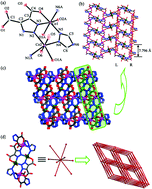Spin canting and metamagnetism in 3D pillared-layer homospin cobalt(ii) molecular magnetic materials constructed via a mixed ligands approach†
Abstract
Two new 3D pillared-layer cobalt(II) molecular magnetic materials, formulated as {[Co2(TDA)(TZ)(H2O)2]·H2O}n (1) and {[Co3(TDA)2(bpy)3]·6.75H2O}n (2) (H3TDA = 1H-1,2,3-triazole-4,5-dicarboxylic acid, HTZ = 1H-1,2,4-triazole and bpy = 4,4′-bipyridine), have been successfully assembled with H3TDA and auxiliary ligands, respectively. In 1, the neighboring Co(II) ions are connected via TDA3− to generate 2D layers, which are further bridged by TZ− to build a 3D 8-connected bcu net with a Schläfli symbol of (424·64), whereas in 2, the nearest Co(II) ions are connected via TDA3− to form a hexagonal [Co6(TDA)6]6− macrocycle composed of 24-membered atoms, which can be further linked to each other to generate 2D Kagomé layers. The Kagomé layers are connected by bpy pillars to display a 3D (3,4,4,4)-connected KAVGAQ net with a Schläfli symbol of {63}2{64·102}{64·82}2. Magnetic studies reveal that both of them show the spin canting and metamagnetic behaviors with critical temperatures of 3.5 K and 4 K, respectively.


 Please wait while we load your content...
Please wait while we load your content...